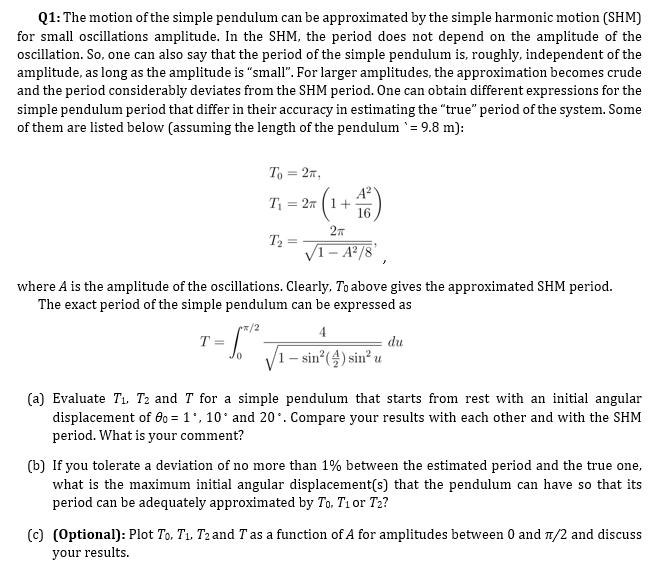Q1:The motion of the simple pendulum can be approximated by the simple harmonic motion (S! or small oscillations amplitude. In the SHM, the period does not depend on the amplitude of scillation. So, one can also say that the period of the simple pendulum is, roughly, independent of mplitude, as long as the amplitude is "small". For larger amplitudes, the approximation becomes cr nd the period considerably deviates from the SHM period. One can obtain different expressions for mple pendulum period that differ in their accuracy in estimating the "true" period of the system. S them are listed below (assuming the length of the pendulum `= 9.8 m): To = 27, T = 27 16 27 T2 = 1 – Aª /8'. here A is the amplitude of the oscillations. Clearly. To above gives the approximated SHM period. The exact period of the simple pendulum can be expressed as /2 4 T du sin°(4) sin² u
Q1:The motion of the simple pendulum can be approximated by the simple harmonic motion (S! or small oscillations amplitude. In the SHM, the period does not depend on the amplitude of scillation. So, one can also say that the period of the simple pendulum is, roughly, independent of mplitude, as long as the amplitude is "small". For larger amplitudes, the approximation becomes cr nd the period considerably deviates from the SHM period. One can obtain different expressions for mple pendulum period that differ in their accuracy in estimating the "true" period of the system. S them are listed below (assuming the length of the pendulum `= 9.8 m): To = 27, T = 27 16 27 T2 = 1 – Aª /8'. here A is the amplitude of the oscillations. Clearly. To above gives the approximated SHM period. The exact period of the simple pendulum can be expressed as /2 4 T du sin°(4) sin² u
Elements Of Electromagnetics
7th Edition
ISBN:9780190698614
Author:Sadiku, Matthew N. O.
Publisher:Sadiku, Matthew N. O.
ChapterMA: Math Assessment
Section: Chapter Questions
Problem 1.1MA
Related questions
Question
b

Transcribed Image Text:Q1: The motion of the simple pendulum can be approximated by the simple harmonic motion (SHM)
for small oscillations amplitude. In the SHM, the period does not depend on the amplitude of the
oscillation. So, one can also say that the period of the simple pendulum is, roughly, independent of the
amplitude, as long as the amplitude is "small". For larger amplitudes, the approximation becomes crude
and the period considerably deviates from the SHM period. One can obtain different expressions for the
simple pendulum period that differ in their accuracy in estimating the "true" period of the system. Some
of them are listed below (assuming the length of the pendulum `= 9.8 m):
To = 27,
A?
1+
16
T1 = 27
27
T2 =
VI- A²/8',
where A is the amplitude of the oscillations. Clearly, To above gives the approximated SHM period.
The exact period of the simple pendulum can be expressed as
*/2
4
T =
du
V1
– sin°(4) sin² u
(a) Evaluate T1. T2 and T for a simple pendulum that starts from rest with an initial angular
displacement of 0o = 1', 10' and 20'. Compare your results with each other and with the SHM
period. What is your comment?
(b) If you tolerate a deviation of no more than 1% between the estimated period and the true one,
what is the maximum initial angular displacement(s) that the pendulum can have so that its
period can be adequately approximated by To. T1 or T2?
(c) (Optional): Plot To. T1, T2 and T as a function of A for amplitudes between 0 and 1/2 and discuss
your results.
Expert Solution
This question has been solved!
Explore an expertly crafted, step-by-step solution for a thorough understanding of key concepts.
This is a popular solution!
Trending now
This is a popular solution!
Step by step
Solved in 2 steps

Knowledge Booster
Learn more about
Need a deep-dive on the concept behind this application? Look no further. Learn more about this topic, mechanical-engineering and related others by exploring similar questions and additional content below.Recommended textbooks for you

Elements Of Electromagnetics
Mechanical Engineering
ISBN:
9780190698614
Author:
Sadiku, Matthew N. O.
Publisher:
Oxford University Press

Mechanics of Materials (10th Edition)
Mechanical Engineering
ISBN:
9780134319650
Author:
Russell C. Hibbeler
Publisher:
PEARSON

Thermodynamics: An Engineering Approach
Mechanical Engineering
ISBN:
9781259822674
Author:
Yunus A. Cengel Dr., Michael A. Boles
Publisher:
McGraw-Hill Education

Elements Of Electromagnetics
Mechanical Engineering
ISBN:
9780190698614
Author:
Sadiku, Matthew N. O.
Publisher:
Oxford University Press

Mechanics of Materials (10th Edition)
Mechanical Engineering
ISBN:
9780134319650
Author:
Russell C. Hibbeler
Publisher:
PEARSON

Thermodynamics: An Engineering Approach
Mechanical Engineering
ISBN:
9781259822674
Author:
Yunus A. Cengel Dr., Michael A. Boles
Publisher:
McGraw-Hill Education

Control Systems Engineering
Mechanical Engineering
ISBN:
9781118170519
Author:
Norman S. Nise
Publisher:
WILEY

Mechanics of Materials (MindTap Course List)
Mechanical Engineering
ISBN:
9781337093347
Author:
Barry J. Goodno, James M. Gere
Publisher:
Cengage Learning

Engineering Mechanics: Statics
Mechanical Engineering
ISBN:
9781118807330
Author:
James L. Meriam, L. G. Kraige, J. N. Bolton
Publisher:
WILEY